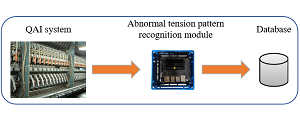Development of the Abnormal Tension Pattern Recognition Module for Twisted Yarn Based on Deep Learning Edge Computing
DOI:
https://doi.org/10.46604/ijeti.2023.11158Keywords:
abnormal yarn tension, deep learning, edge computing, twisted yarn, long short-term memoryAbstract
This study aims to develop an artificial intelligence module for recognizing abnormal tension in textile weaving, The module can be used to address the time-consuming and inaccurate issues associated with traditional manual methods. Long short-term memory (LSTM) recurrent neural networks as the algorithm for identifying different types of abnormal tension are employed in this module. This study focuses on training and validating the model using five common patterns. Additionally, an approach involving the integration of plug-in modules and edge computing in deep learning is employed to achieve the research objectives without altering the original system architecture. Multiple experiments were conducted to search for the optimal model parameters. According to the experimental results, the average recognition rate for abnormal tension is 97.12%, with an average computation time of 46.2 milliseconds per sample. The results indicate that the recognition accuracy and computation time meet the practical performance requirements of the system.
References
Y. LeCun, Y. Bengio, and G. Hinton, “Deep Learning”, Nature, vol. 521, no.7553, pp. 436-444, May 2015.
A. Canziani, A. Paszke, and E. Culurciello, “An Analysis of Deep Neural Network Models for Practical Applications,” https://arxiv.org/abs/1605.07678, April 14, 2017.
R. Zhang, F. Meng, Y. Zhou, and B. Liu, “Relation Classification via Recurrent Neural Network with Attention and Tensor Layers,” Big Data Mining and Analytics, vol. 1, no. 3, pp. 234-244, September 2018.
A. Krizhevsky, I. Sutskever, and G. E. Hinton, “ImageNet Classification with Deep Convolutional Neural Networks,” Communications of the ACM, vol. 60, no. 6, pp. 84-90, June 2017.
I. Goodfellow, J. Pouget-Abadie, M. Mirza, B. Xu, D. Warde-Farley, S. Ozair, et al., “Generative Adversarial Networks,” Communications of the ACM, vol. 63, no. 11, pp.139-144, November 2020.
P. Henderson, R. Islam, P. Bachman, J. Pineau, D. Precup, and D. Meger, “Deep Reinforcement Learning That Matters,” Proceedings of the AAAI Conference on Artificial Intelligence, vol. 32, no. 1, pp. 3207-3214, 2018.
R. Hadidi, J. Cao, Y. Xie, B. Asgari, T. Krishna, and H. Kim, “Characterizing the Deployment of Deep Neural Networks on Commercial Edge Devices,” 2019 IEEE International Symposium on Workload Characterization, pp. 35-48, November 2019.
S. L. Chen and L. W. Huang, “Using Deep Learning Technology to Realize the Automatic Control Program of Robot Arm Based on Hand Gesture Recognition,” International Journal of Engineering and Technology Innovation, vol. 11, no. 4, pp. 241-250, September 2021.
C. C. Ho, E. Su, P. C. Li, M. J. Bolger, and H. N. Pan, “Machine Vision and Deep Learning Based Rubber Gasket Defect Detection,” Advances in Technology Innovation, vol. 5, no. 2, pp. 76-83, April 2020.
R. Bhagwat and Y. Dandawate, “A Framework for Crop Disease Detection Using Feature Fusion Method,” International Journal of Engineering and Technology Innovation, vol. 11, no. 3, pp. 216-228, June 2021.
A. Sherstinsky, “Fundamentals of Recurrent Neural Network (RNN) and Long Short-Term Memory (LSTM) Network,” Physica D: Nonlinear Phenomena, vol. 404, article no.132306, March 2020.
S. Hochreiter and J. Schmidhuber, “Long Short-Term Memory,” Neural Computation, vol. 9, no. 8, pp. 1735-1780, November 1997.
S. Hochreiter and J. Schmidhuber, “LSTM Can Solve Hard Long Time Lag Problems,” Proceedings of the 9th International Conference on Neural Information Processing Systems, pp. 473-479, December 1996.
F. A. Gers, N. N. Schraudolph, and J. Schmidhuber, “Learning Precise Timing with LSTM Recurrent Networks,” Journal of Machine Learning Research, vol. 3, pp. 115-143, January 2003.
N. Michielli, U. R. Acharya, and F. Molinari, “Cascaded LSTM Recurrent Neural Network for Automated Sleep Stage Classification Using Single-Channel EEG Signals,” Computers in Biology and Medicine, vol. 106, pp. 71-81, March 2019.
Q. Jiang, C. Tang, C. Chen, X. Wang, and Q. Huang, “Stock Price Forecast Based on LSTM Neural Network,” Proceedings of the Twelfth International Conference on Management Science and Engineering Management, pp. 393-408, 2019.
C. P. Lu and J. J. Liaw, “Yarn Tension Pattern Retrieval System Based on Gaussian Maximum Likelihood,” International Journal of Innovative Computing, Information and Control, vol. 7, no. 11, pp. 6261-6272, November 2011.
G. Cao and C. Q. Ma, “A High Speed Measuring System of Yarn Tension Based on Direct Memory Access,” 2011 Third International Conference on Measuring Technology and Mechatronics Automation, vol. 1, pp. 66-69, January 2011.
M. M. Khodier, S. M. Ahmed, and M. S. Sayed, “Complex Pattern Jacquard Fabrics Defect Detection Using Convolutional Neural Networks and Multispectral Imaging,” IEEE Access, vol. 10, pp. 10653-10660, 2022.
NVIDIA, “Official TensorFlow for Jetson Nano,” https://forums.developer.nvidia.com/t/official-tensorflow-for-jetson-nano/71770, March 16, 2022.
Keras, “LSTM Layer,” https://keras.io/api/layers/recurrent_layers/lstm, March 20, 2022.
D. P. Kingma and J. Ba, “Adam: A Method for Stochastic Optimization,” Proceedings of the 3rd International Conference on Learning Representations, May 2015.

Published
How to Cite
Issue
Section
License
Copyright (c) 2023 Chuan-Pin Lu, Yan-Long Huang, Po-Jen Lai

This work is licensed under a Creative Commons Attribution-NonCommercial 4.0 International License.
Copyright Notice
Submission of a manuscript implies: that the work described has not been published before that it is not under consideration for publication elsewhere; that if and when the manuscript is accepted for publication. Authors can retain copyright in their articles with no restrictions. Also, author can post the final, peer-reviewed manuscript version (postprint) to any repository or website.

Since Jan. 01, 2019, IJETI will publish new articles with Creative Commons Attribution Non-Commercial License, under Creative Commons Attribution Non-Commercial 4.0 International (CC BY-NC 4.0) License.
The Creative Commons Attribution Non-Commercial (CC-BY-NC) License permits use, distribution and reproduction in any medium, provided the original work is properly cited and is not used for commercial purposes.







.jpg)


